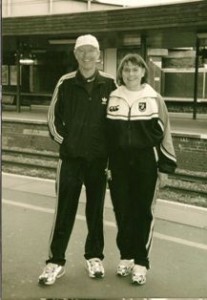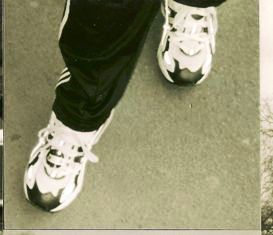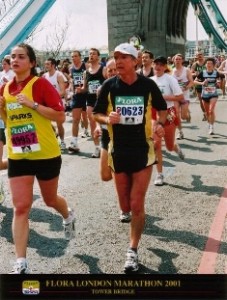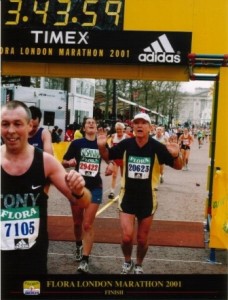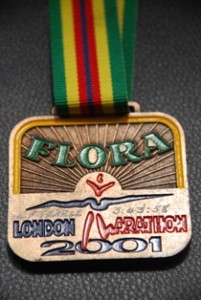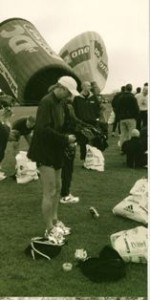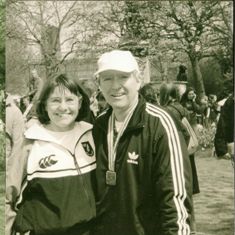Dear Mum and Dad
Just a short note to let you know that I’m home safely after running the London Marathon this morning. My time is sub-3:45:00, meaning about 3:44:10hrs. I had hoped for a sub 3:30:00 but I just have to accept the time I’ve got. It’s not a bad time for 54-yr old running his first marathon, and his first London Marathon at that, after only 3 years and 3 months of any sort of running. And I’ll tell you what, there were an AWFUL lot of people behind me! When I was running past the 21 mile mark, with Tower Bridge just in front of me, I could see lots of people just passing the 13 mile mark, and no sign of the tail of the competitors. They had taken nearly 3 hours to get half-way and they still had a long way to go .
London being what it is, and the trains being in the condition they are, we couldn’t go directly to London Bridge Station and then off to Blackheath. We caught the train from St Albans to London Bridge, but just before Kings Cross Station we were told by the train driver that due to engineering work, he wasn’t stopping at London Bridge and we’d have to get off at Kings Cross and find another way to Blackheath. Up to that very moment we’d had assurances from the rail people that all was in order. We got to Blackheath Station near Greenwich Park after having to miss three trains because they were all full, but only with 10 minutes to spare before I had to throw my kit onto the back of the truck that would take it to the finish for me. It was a close thing, and Elaine said there were lots of people who actually missed the start and had to run through the assembly area just to catch the field.
It’s quite a flat course, a little downhill if anything, and very pleasant to run on those roads. All the way it was jammed with runners, I always had to be careful where I ran so as not to trip up or be tripped, but at least half a dozen people in front of me went down. None of them looked hurt, but it would be a difficult thing to recover from completely.
It must have been quite a cold day, because when I drank the water from the bottles that were handed out nearly every mile, I thought they must have taken the bottle from the fridge. It really chilled my skin when I threw some water over myself. However, the weather made very good running conditions because I never once felt over-hot, it was just a nice comfortable temperature all the way round.The beautifully soft and very light running suit that Genevieve had bought for me made such a difference, too. I’d never worn anything before that was so light and so comfortable.
During the 12th mile, we crossed Tower Bridge and that was a real highlight. There were lots of people watching and a wonderful amount of noise. At the 13 mile point, there is a short section of road where I could see the leaders of the marathon passing the 21 mile mark and heading for the finish. I saw Teargat, who was second, and Antonio Pinto, who was about 5th. Paul Teargat was running his first ever marathon and I heard he’d finished second. Not bad. It was just fortunate timing that I saw them. Any later or any earlier and I’d have missed them because the section where the homecomers could see the outgoers is quite a short stretch of road.
The very, very worst part of the marathon was mile 23. The course seems endless and the pain is awful. I told myself that I would never walk. No matter how slowly I ran, it would still be faster than walking and I was also absolutely sure that if I walked, I’d stop. I have never walked in a race before and today wasn’t going to be the first time. It could have taken another hour to get to the finish. At mile 25, there is no mile 26, just the finish 1.2 miles away. When I saw Buckingham Palace on my left, and passed the Victoria Memorial as I rounded into The Mall, then I finally felt that nothing could stop me. I could see the finish clock in front of me and it was about 3:42:00 and I saw 3:43:55 as I crossed the line, so that’s why I think my final time will be about 3:44:10-ish. But well under 3:45:00.
I crossed the finish mat that recorded the time from the chip on my foot, then I stopped. After that, it was all agony. I could hardly walk, every step was an effort and I was gasping from the pain. I had to walk up a little ramp to get the chip removed from my running shoes and then I had to walk down the other side, clutching onto the railing. A lovely lady put the London Marathon finisher’s medal round my neck and gave me a quick peck on the cheek and someone else swung a space blanket (it’s a blanket made of very warm, shiny material) round my shoulders and I limped down the whole line of The Mall to find the truck with my kit bag on it. Someone gave me a goody bag of London Marathon stuff with a t-shirt, some sports bars, some drinks and an apple. Just as I found the truck and collected my kit, Elaine and Karen yelled enthusiastically from behind the tall wire fence that kept the runners’ area secure. It was a terrible effort to sit and get changed and an even worse effort to get up. I was very impressed that they had managed to find me with all those people milling about, but they had gone looking for the numbered truck with my kit in it. Very intelligent.
We walked to Trafalgar Square and down the tunnel to Charing Cross, from there the train to Leicester Square for Kings Cross and from there … Home. People on the trains and in the tunnels who saw my London Marathon medal (of course I wore it home! And I’m taking it to work at Tesco tomorrow, too) engaged me in very pleasant conversation, commiserated with me on my agony and charmingly commented on my time.
During the week I had lots of phone calls from our English friends and family, including Thelma, Roland and Jennie. We also had lots of lovely emails from friends and family in New Zealand and Genevieve rang a couple of times as well.
Ivor Adams rang to see how things went, Roland rang to see how I was and Ivor’s daughter, Jill and husband Dave, came round to see us and to swap jokes with the cripple. I’ve had emails of encouragement this morning from friends in Te Kuiti, Otorohanga and Hamilton and Nick and Sally Trout from Warnham sent one, too. I also had an absolutely beautiful card with encouragement, and lots of stickers, from Karen before we left this morning. I have had a wonderful day.
Elaine’s view of the London Marathon while Ewart did the hard job of running it.
The main marathon event began for me last Wednesday when I went to London on Ewart’s behalf (armed with signed authority, ID, and a list of tasks to complete) to collect Ewart’s gear bag, computer chip, runner’s number etc. The fun really began on the tube sitting at Charing Cross Station on the Jubilee Line waiting for the Docklands Light Rail. It was the first morning to collect such articles and people were arriving from all over to find London Arena, just like me.
I wore my new Canterbury tracksuit, bought in NZ for me by Ewart especially for the marathon and my NZ All Blacks t-shirt. On the platform apparently I looked like someone who knew where I was going because English people kept asking me for directions. It was quite a laugh really but I met some lovely people this way and we travelled on the trains together, chatting about the marathon all the way and going our own separate ways on arrival.
The Arena was easy to find – it’s in the Docklands area of London where huge and very impressive expansion projects are going on. On arrival the 2001 Space Odyssey music blasted forth and that really set the tone for a great day. Everything was really well organised so getting Ewart’s gear (through several steps) was very simple and that left my day free to enjoy the marathon exhibition and enjoy it I did. At the end of the day, after some shopping for Genevieve at Canary Wharf, I dragged my very weary body home ready for the days ahead.
The first of those days was quiet and just required providing the right sort of foods at the right times for when Ewart needed them and having a quiet rest – you know, marking, stuff like that.
Saturday was market day, so I had to get the right foods, cook at different times to get the right amount of food in and make final arrangements with our special neighbour, Karen. There were lots of emails and phone calls wishing Ewart well and with all the cards sitting about, our flat was quite festive. Followed by an early night.
THE BIG DAY
The marathon went really well. We got up at 4.50am and made ourselves ready to go. Karen arrived here at 5.45am and we headed by car for St Albans station, travelled by Thameslink train to London … and then the fun started. We intended to travel direct to London Bridge station but just short of Kings Cross the driver came on the intercom to say that due to engineering work, this train would not be stopping at London Bridge. We would have to get off at Kings Cross and go to London Bridge via the Northern Line. The Northern Line is the furthest walk through the tunnels of any of the lines at Kings Cross so we set off at quite a pace so as not to use up valuable time. We waited on the platform with lots of other people, white plastic gear-bag in hand, heading for the marathon.
After about ten minutes a voice came over the intercom telling all the marathon people to head for the Victoria Line because the Northern Line was closed. We went to the Victoria Line platform and waited; the train was late, then the one that did come was full and we couldn’t fit on. We waited for the next train while time ticked by. We caught the next train to Green Park, then more walking through tunnels to the Jubilee line and caught that train to London Bridge. Then we had to go to find Connex.
Once there we ran into all the other people (hundreds by then) who had been caught by the train problems. We stood on platform 5 and watched the first three trains come and went and we couldn’t get on. I met one man who told me he had started north of us at Hertford. He had sat on that station for 15mins with other runners, finally to have the intercom tell him that no trains were going from Hertford to London that day, despite his having checked with the railways the previous day. He had had to ring his wife to drive him and a group of runners to St Albans to catch our train – and be there by 6.24am! Most of the trains from London Bridge could only take a few people because the trains were full before they got to us.
London being what it is, and the trains being in the condition they are, we couldn’t go directly to London Bridge Station and then off to Blackheath. We caught the train from St Albans to London Bridge, but just before Kings Cross Station we were told by the train driver that due to engineering work, he wasn’t stopping at London Bridge and we’d have to get off at Kings Cross and find another way to Blackheath. Up to that very moment we’d had assurances from the rail people that all was in order. We got to Blackheath Station near Greenwich Park after having to miss three trains because they were all full, but only with 10 minutes to spare before I had to throw my kit onto the back of the truck that would take it to the finish for me. It was a close thing, and Elaine said there
Finding a loo was fun. We found some for the athletes but the queues were horrific so Karen and I decided we could wait. Just…
We wished Ewart well and just before the 9:30 am start time headed back to Blackheath Station. We couldn’t find the start line anyway because there were thousands of people (plus tens of thousands of runners) and large hot air balloons as well, including a couple we recognised from the Hamilton Balloon Fiesta. We found a nice coffee shop and rested there for about 1/4 hour. During that time, the race had started and some time later we saw runners still arriving with their gear bags and running to try to catch the start.
From what we understand, the start area was so huge that there were runners starting when the leaders reached the eight-mile mark. For the London Marathon everyone’s time is counted
from the start gun regardless of whether you make it over the start line very quickly.
Karen and I found the station and joined the queues for trains to the underground once more. We decided to go via Victoria, so we flagged the train to Charing Cross because it was too full anyway. When our train was due the announcer came on to say our train would be ten minutes late. We were beginning to get used to this and started to laugh. Others on the platform looked sideways at us and Karen said, “Welcome to England!” We were both dressed as Kiwis but Karen’s mum is Irish and her dad English. We were just having a fun day out.
On arrival at Victoria we had similar adventures but finally found a train to get us to Tower Bridge where we hoped to catch Ewart at the 13 and 22 mile points as they were opposite each other. We didn’t find that place immediately, because there were far too many people, so we grabbed an ice ream and went to the end of Tower Bridge, next to the Tower of London – and found a great atmosphere there anyway. We had to stand on tip-toe for a long time checking out every runner with a white cap heading towards the half-way mark.
I finally spotted Ewart. We screamed “GO EWART” at the top of our lungs then headed back to the underground for our next adventure. Out came the map and we decided to head to St James Park, arriving by The Home Office. Once there we found we were just 800 metres from the finish line and fortunately Karen spotted a gap in the fence so we could be right at the front. We could see at last!!! We’d felt REALLY SHORT until then, though. We stayed there for about 1 1/2 hours looking at every white cap, yellow and black strip etc. Our eyes hurt and streamed and we cheered on anyone who got into difficulty or who looked interesting. Finally we spotted Ewart and screamed at the top of our lungs again. People around us looked at us VERY STRANGELY. Then we took off towards Buckingham Palace.
Here it got really crowded and it was very difficult to get through the crowd. We caught a glimpse of runners from time to time and photographed the beautiful tulips in the palace gardens. I also saw the plaques for the Diana Princess of Wales Walk in the pavement. From here on the going got really difficult and we could only go a few paces at a time whenever the crowd would let us through.
We found the finish line on The Mall and watched people finishing, being awarded their medals and getting their computer chips removed. As each runner finished they were wrapped in a reflective, metallic-looking sheet, called a space blanket, to keep warm. I spotted the numbered trucks where we had earlier deposited Ewart’s gear and knew just which truck his would be in, so we headed for it.
We had to stay beyond the perimeter fence and we took photos of things we thought Ewart would want to see afterwards. We spotted Ewart quite quickly and called to him, taking a photo of him with his medal and space blanket. We waited for him to change then we walked parallel with him until we could be on the same path. He was very stiff and sore by this stage, but very happy. He had finished the marathon in 3 hours 44 minutes. It was a fantastic time for a first marathon, in fact for any marathon.
We were REALLY proud of him. We walked at his painful and very delicate pace to Trafalgar Square and then through the underground tunnels to Charing Cross station. People were happy, chatting to each other, showing medals and comparing times. It was really great to be part of and fortunately the train trip home was much less eventful. At St Albans station a couple of black guys who worked at the station called to Ewart to see his medal and made him and us feel really special. They were so happy and excited just to share Ewart’s triumph with him. We finally got back to the flat at 4pm, very tired but extremely happy, kind of high really.
Since then it has been all celebration. Dave and Jill had driven up from Ashtead to see Ivor and Iris and they called round see us. That was a lovely surprise and a perfect way to wind down after a big day. There were lovely emails and phone calls to follow, yesterday and today – from everywhere. Ewart has had a great day with his work mates today and I with mine. Ewart took his medal to work today and he got a great reception. None of them knew he was running. Tomorrow it goes with me to school. The children knew he was running and are excitedly waiting to hear how he got on.
It was a wonderful adventure for us all. For me, I am pleased to be the “gopher” and “spectator” but none the less a participant. For Ewart it is one of the greatest achievements of his life. Thanks for your support. You made a big difference to the last two years of training for this event. Genevieve was wonderful: she phoned us, wrote lots of encouraging emails and bought the lovely running suit that Ewart ran in for the race. It was truly a great family day for us.
Lots of love
Elaine
Results:
Time: 3:43:58 hr Place: 6453 Finishers: 33,000 Starters: 44,000
The London Marathon is a world event, so that puts Ewart in the top 20% of marathon runners world-wide.
